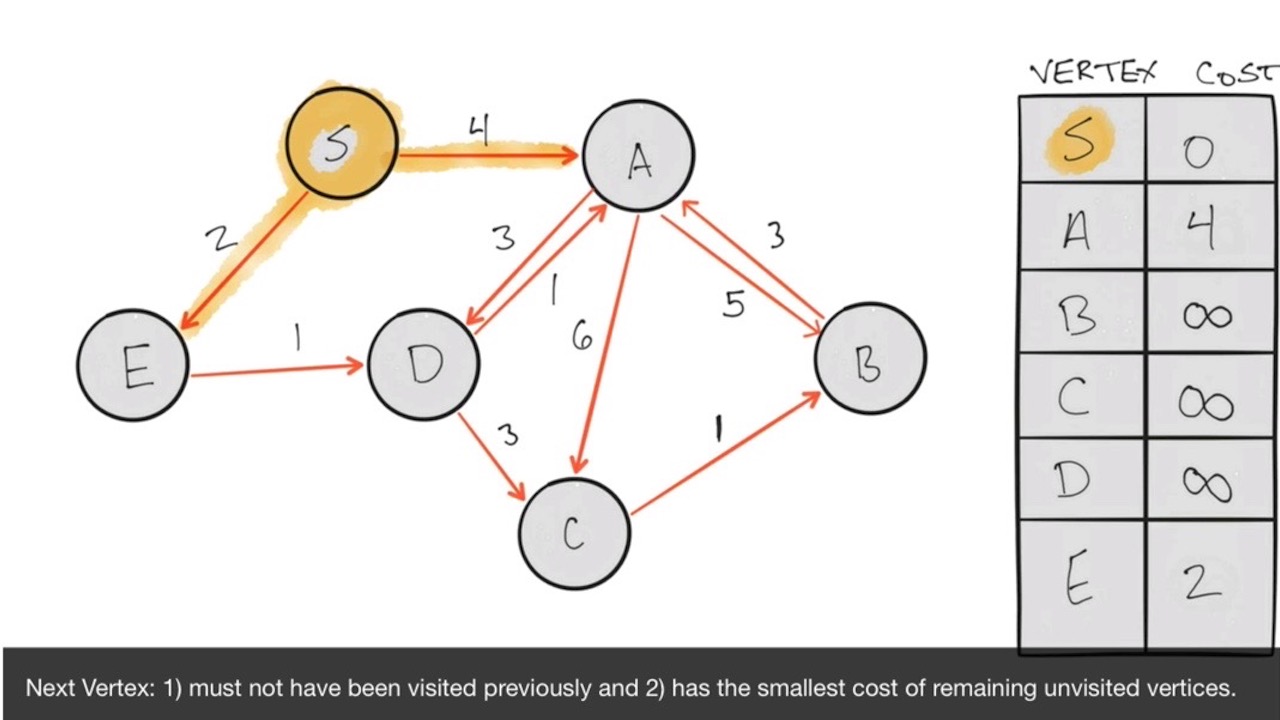In the last chapter we iterated over a simple graph using Bellman-Ford to find the shortest paths from a single vertex (our source) to all other vertices in the graph.
The complexity of Bellman-Ford is O(|V| E), which can approximate O(n^2) if every vertex has at least one outgoing edge. In other words: it's not terribly efficient.
Dijkstra's algorithm requires only one iteration, however and has a complexity of O(|V| log V), which is much more efficient.
As with Bellman-Ford, we'll use a directed, weighted graph with 6 vertices. In addition, we'll setup a memo table with our source S set to 0 and the rest of the vertices set to infinity.
There is a difference here, however, and it's critical! Dijkstra doesn't work with negative edge weights! I have adjusted this graph so that we don't have any negative weights, as you can see. Specifically the edges between S and E as well as C to B. In addition I've added a few edges to show that the algorithm will scale easily regardless of the number of edges involved.
//Dijkstra: Shortest path calculation//on an edge-weighted, directed graphclass MemoTable{ constructor(vertices){ this.S = {name: "S", cost: 0, visited: false}; this.table = [this.S]; for(var vertex of vertices){ this.table.push({name: vertex, cost: Number.POSITIVE_INFINITY, visited: false}); } }; getCandidateVertices(){ return this.table.filter(entry => { return entry.visited === false; }); }; nextVertex(){ const candidates = this.getCandidateVertices(); if(candidates.length > 0){ return candidates.reduce((prev, curr) => { return prev.cost < curr.cost ? prev : curr; }); }else{ return null; } }; setCurrentCost(vertex, cost){ this.getEntry(vertex).cost =cost; }; setAsVisited(vertex){ this.getEntry(vertex).visited = true; }; getEntry(vertex){ return this.table.find(entry => entry.name == vertex); }; getCost(vertex){ return this.getEntry(vertex).cost; }; toString(){ console.log(this.table); }};const vertices = ["A", "B","C", "D", "E"];const graph = [ {from : "S", to :"A", cost: 4}, {from : "S", to :"E", cost: 2}, {from : "A", to :"D", cost: 3}, {from : "A", to :"C", cost: 6}, {from : "A", to :"B", cost: 5}, {from : "B", to :"A", cost: 3}, {from : "C", to :"B", cost: 1}, {from : "D", to :"C", cost: 3}, {from : "D", to :"A", cost: 1}, {from : "E", to: "D", cost: 1}]const memo = new MemoTable(vertices);const evaluate = vertex => { const edges = graph.filter(path => { return path.from === vertex.name; }); for(edge of edges){ const currentVertexCost = memo.getCost(edge.from); const toVertexCost = memo.getCost(edge.to); const tentativeCost = currentVertexCost + edge.cost; if(tentativeCost < toVertexCost){ memo.setCurrentCost(edge.to, tentativeCost); } }; memo.setAsVisited(vertex.name); const next = memo.nextVertex(); if(next) evaluate(next);}//kick it off from the source vertexevaluate(memo.S);memo.toString();
